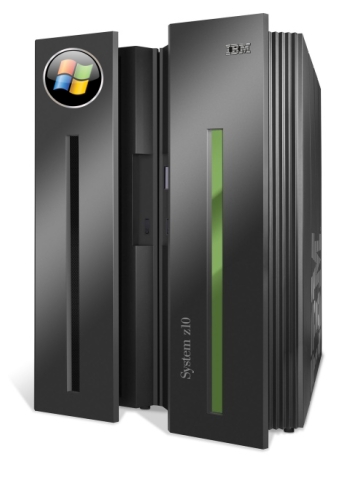You're Gonna Need a Bigger Mouse for that Mainframe

At the SHARE conference in Austin, Texas, the Birmingham, Alabama-based Mantissa Corporation unveiled z/VOS, a hypervisor that enables Windows desktops and servers to be virtualized on IBM mainframes.
I don't generally like to blog about IBM technology on Tech Broiler because as an IBM employee, much of what I say could be considered a conflict of interest -- so I try to stick with topics that are general to the industry and have broad appeal. This time, however, as it concerns a 3rd-party vendor, I'm making an exception.
Click on the "Read the rest of this entry" link below for more.
I've known about the development of Mantissa's z/VOS for about seven months, although I learned of it first here on Tech Broiler, via a comment posted by Mantissa's CEO, Gary Dennis, on an article I wrote about x86 possibly losing its relevancy. In that article, I suggested that Microsoft port Windows to z/VM natively, running on IFL processors, much like Linux runs on the architecture today.
After all, Windows NT was ORIGNALLY designed to have a portable kernel with a hardware abstraction layer, it once ran on PowerPC, NEC MIPS and Intel i860 RISC processors, and of course Windows still runs on HP's/Intel's Itanium. So a native port to z/Architecture seemed like it would make more sense then emulating x86 machines on a very foreign systems architecture, initially.
What I didn't count on is a vendor actually re-implementing the x86 environment within an emulated container on the z-Series. That just seemed too crazy, because the thunking and instruction translation challenges involved to achieve good performance seemed immense.
But when there is a will, then there is a way. And apparently, Mantissa does have a way.
Granted, I've never seen this product demoed. I don't have any architectural whitepapers from Mantissa, and I can only surmise as to how the thing actually works. The company has been extremely tight-lipped about their product. I will say this, however -- if it does work, then the "Screen" I wrote about last week just became a big step closer to reality.
Obviously, Mantissa will have a lot of hurdles to overcome -- Mainframes are not small purchases, even with "Baby Z's" so not just everyone is going to see IBM mainframes as a viable x86 virtualization or server consolidation solution. The price/performance ratio of Mainframe-based Windows hosting versus bare-metal or x86 virtual infrastructure via VMWare/Xen/Hyper-V/KVM will really have to be calculated and put to the test.
Then there are the legal issues that Mantissa may have to deal with from companies like Intel who might feel threatened by what this might mean to their core business if very large companies start getting the idea that they can run thousands of Windows instances on one IBM mainframe alongside native z/Linux and z/OS apps instead of on 1000 clustered servers.
There is also the challenge of overcoming a ton of performance issues -- since the x86 architecture is being completely emulated, there's all that I/O translation and such that has to occur. Does it make sense from a cost and performance standpoint to consolidate your MS SQL Server infrastructure, Sharepoint or corporate Exchange or Active Directory on a z10 T-Rex? I dunno.
Disclaimer: The postings and opinions on this blog are my own and don’t necessarily represent IBM’s positions, strategies or opinions.
[poll id="14"]

![Reblog this post [with Zemanta]](http://img.zemanta.com/reblog_e.png?x-id=ab796a04-7dd5-49ff-8eaf-c1602fc5165c)